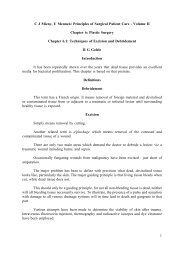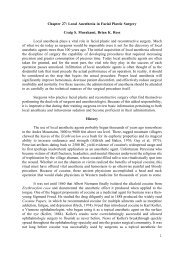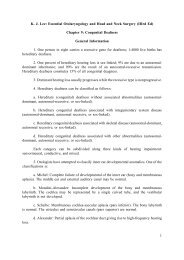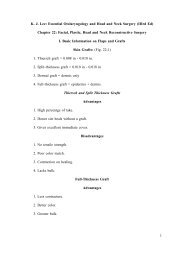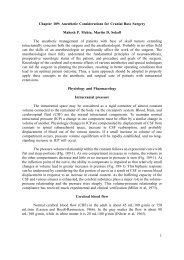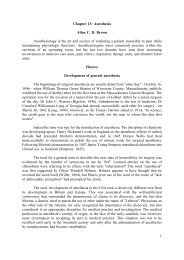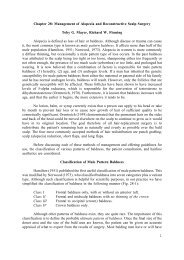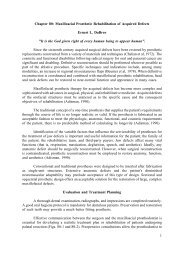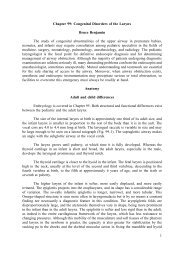1 Chapter 8: Skin Flap Physiology George S. Goding ... - Famona Site
1 Chapter 8: Skin Flap Physiology George S. Goding ... - Famona Site
1 Chapter 8: Skin Flap Physiology George S. Goding ... - Famona Site
You also want an ePaper? Increase the reach of your titles
YUMPU automatically turns print PDFs into web optimized ePapers that Google loves.
in volume, but only a 10% decrease in velocity were observed. Sixty minutes after a venous<br />
occlusion a moderate decrease in LDF (70%) and velocity (50%), but only a small decrease<br />
in volume (15%) were detected.<br />
The quality of blood flow estimation with the laser doppler has had a mixed review.<br />
Marks et al (1984) felt that the laser doppler, like fluorescein, becomes more accurate at 24<br />
hours after flap elevation. Liu et al (1986) felt that the laser doppler was more likely to reflect<br />
nonnutritive blood flow in the immediate period after flap elevation. Sloan and Sasaki (1985)<br />
found the laser doppler to have an increased variability and had difficulty reproducing results.<br />
Reports of blood flow in nonperfused tissue have also been published (Fischer et al, 1985;<br />
Marks et al, 1984; Sloan and Sasaki, 1985). For this reason percentage change rather than<br />
absolute values are often followed when using the laser doppler clinically.<br />
Heden et al (1986) found the laser doppler to be as accurate as fluorescein in the rad<br />
dorsal flap if certain techniques were followed. This included immobilization of the skin to<br />
probe interface and monitoring a single site. The laser doppler has been used to monitor<br />
myocutaneous flaps (Cummings et al, 1984) and free flaps in humans. The laser doppler has<br />
the advantage of being relatively simple to use and is noninvasive and thus is an attractive<br />
option for continuous monitoring of revascularized tissue (Silverman et al, 1985).<br />
Metabolic monitoring<br />
Glinz and Clodius (1972) evaluated pH measurements in the subcutaneous tissue of<br />
pig pedicle flaps and found pH to be a reliable indicator of tissue necrosis. They found that<br />
tissues with a pH more than 0.35 units lower than adjacent normal tissue did not survive.<br />
Dickson and Sharpe (1985) studied pH changes in rat epigastric island flaps by placing a pH<br />
probe into the middle of the flap. They found a measurable fall in pH within a minute of<br />
clamping the pedicle. Arterial occlusion led to a faster pH fall to lower values than venous<br />
occlusion. In pig rectus abdominis flaps, pH measurement had similar results (Warner et al,<br />
1989). The pH changes in their study were nearly identical for the subcutaneous and muscular<br />
layers.<br />
Mahone and Lista (1988) used a pO 2 probe to monitor rabbit epigastric flaps. The<br />
measurement is based on the reduction of oxygen across an electrode pair. The pO 2 of the<br />
surrounding tissue is proportional to the current produced between the anode-cathode gap. In<br />
this study, arterial and venous occlusion could not be differentiated. Occlusion of the entire<br />
pedicle could be detected with an oxygen challenge test in which 100% oxygen was<br />
administered. If the pedicle was intact, measured pO 2 increased three to four fold. This<br />
increase was not present when the pedicle was occluded.<br />
Temperature monitoring of flaps has been criticized for having a slow response time<br />
and a small response (Warner et al, 1989). Monitoring of surface temperature is easy to obtain<br />
and requires simple equipment. Temperature probes can provide a continuous estimate of flap<br />
perfusion. <strong>Skin</strong> temperature is related to blood flow but not always in a predictable or reliable<br />
fashion. The temperature-blood flow relationship is influenced by core temperature, air<br />
temperature, humidity, light, and vasomotor responses. In the laboratory, Sloan and Sasaki<br />
(1985) found good correlation between temperature and survival, but noted that pedicle<br />
occlusion will be detected earlier by administration of cutaneous oxygen and fluorescein.<br />
14




